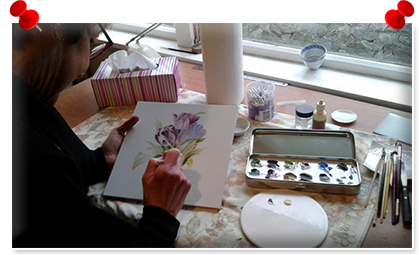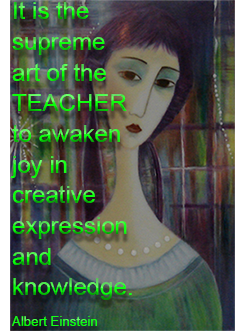
❝Teachers are integral to the heart of ArtOnPorcelainNZ. This is a general guide for teachers and/or artists who have the passion and a desire to teach the art of painting on porcelain.❞
If you have a passion for helping porcelain artists improve their skills or you love to promote the intricacies of porcelain creations, ArtOnPorcelainNZ is definitely the place where you can reach an attentive audience. If you're a teacher and want to find out how to be part of our community you can contact us here...
Photo Credit (Top right): ©Teacher Sandra Austin - Student Anne
 Inspire
Inspire
Great teachers of the art of painting on porcelain have two things in common: an exceptional level of devotion to our art, and the drive to inspire each student to learn and succeed.
 Mentor
Mentor
It cannot be stressed enough, ❝Good teachers need to know their craft.❞ In addition to the methodology of the art of painting on porcelain successful teachers are masters of their subject. A teacher needs to have a good knowledge and familiarity of art, colour, materials used and be versatile in their abilities of the different and many forms, styles, and techniques of painting on porcelain. A teacher may prefer to "specialise" in a particular style or technique.
 Encourage
Encourage
Successful teachers have a positive attitude; negative energy zaps creativity and it makes a breeding ground for fear of failure by a student. Good teachers have an upbeat mood, a sense of vitality and energy. A student wants a teacher who is creative and has a contagious enthusiasm for the art of painting on porcelain; a teacher who is warm, accessible, and approachable.
 Guide
Guide
A teacher needs to be well prepared for the lesson and display a good technique of the subject matter and be able to transmit that knowledge on to their student. Being prepared means you can capitalise on every second and won't have to spend time thinking about what to do next. Creating a welcoming environment and engaging a student from minute one is key. Starting with something "simple and easy" with a lesson on how to use a brush or a pen and different painting techniques I find always to be a more positive approach.
 Praise
Praise
Successful teachers use praise authentically. A student needs encouragement yes, but real encouragement. You don't want to create an environment where there is no praise or recognition; you want to create one where the praise that you offer is valuable BECAUSE you use it judiciously. There's no doubt learning to paint on porcelain does take time and effort, and there is no one teaching strategy, but helping "guide" your student on their painting journey is a universal requirement.
 Flexibility
Flexibility
A great teacher can "shift-gears" and be flexible. Great teachers provide diverse learning experiences as some students may like novelty; they have a great appetite for learning to paint in different ways with different techniques while some students can feel a little frustrated; find something that will inject a little fun into the lesson whilst trying to find a reason for the frustration and endeavouring to remedy it. Encouraging your student to find what they like and are interested in learning makes the whole exercise very enjoyable.

 Creative & Positive
Creative & Positive
It is important for a teacher to be able to maintain a creative environment and guide their student carefully and with positive encouragement, taking care not to over correct but guide by demonstration and example; all reinforced by ongoing, tactful feedback from the teacher that helps students improve as they continuously revise their work toward their goal. Adding a little humour to the class can have the effect of alleviating any nervousness too.
 The Lesson
The Lesson
The average lesson is usually 2½ hours long, but this can be flexible to fit in with both parties. I always like to sit down with my student and have a chat as they unpack their kit. We also have a chat over a cup of tea or coffee. This helps to relax them and we discuss what we will be doing that lesson. This usually takes about 15-20 minutes, then it's into the studio to start the lesson.
 Fees
Fees
All teachers have their own scale of fees. A teacher and student can work collaboratively - working out what each lesson will cost and how long the duration of each lesson will be. A teacher needs to include materials either all in one cost or an hourly rate for the lesson with extra cost like paints or china paid for as and when used. Firing a student's pieces can also be a cost to charge separately.
 Learning Environment
Learning Environment
Always have the room where you are teaching comfortable and warm. Or cool if in the summer. Try to keep your room reasonably tidy and all materials organised and orderly. Students need to have their kit with them and also have spare porcelain on hand if they have finished a piece and they would like to start painting another piece. This can be determined and arranged prior to the next lesson if a teacher deems it the next step in the learning process.
 PATNZ
PATNZ
In New Zealand we have different associations in regional areas. They have regular monthly meetings and yearly exhibitions. We also have PATNZ (Porcelain Art Teachers New Zealand) which run a diploma course in the 17 various disciplines of porcelain painting. There are many teachers in New Zealand to go to.
 Affiliated Associations
Affiliated Associations
In Australia they have APAT (Australian Porcelain Art Teachers Association) for teachers to meet and discuss methods, different techniques, and hold workshops. Every two years each state in Australia organise major exhibitions to which an international artist (or artists) come to share their knowledge and take seminars. This association is recognised internationally and to become a member you need to be teaching for 2 years and have 5 students or more. You also need to pass an assessment and be proposed by two APAT members. IPAT (International Porcelain Art Teachers) and World Porcelain Artists are available for teachers and each have their own merits. It is advisable for students to look for an accredited teacher if they have the opportunity.
 The Key for Teachers
The Key for Teachers
Learn, learn, and never stop learning. Successful artists stay curious!

Sandra Austin
President
Porcelain Art Teachers New Zealand

Art Credit: ©Sandra Austin "Lady With Purple Hair"
